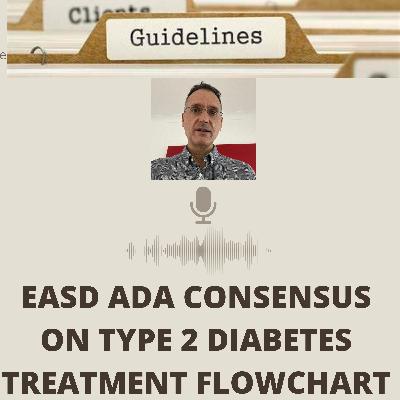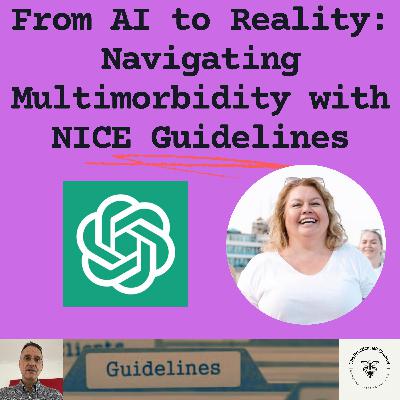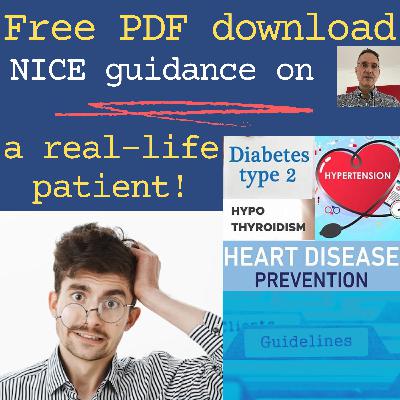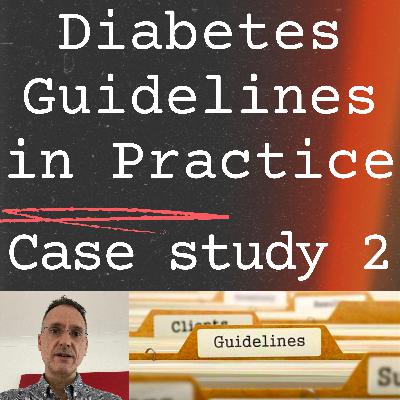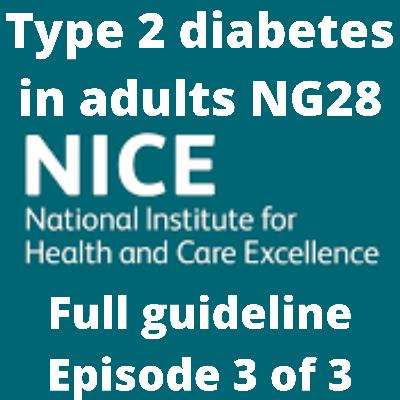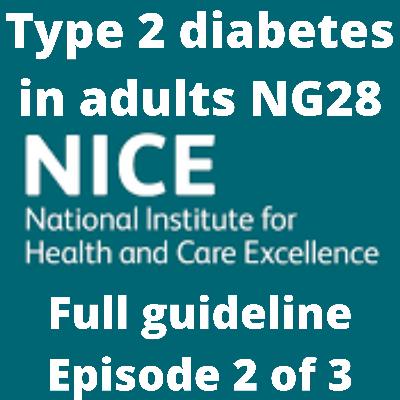EASD ADA consensus guidelines on type 2 diabetes
Description
Episode: EASD ADA consensus guidelines on the overall approach in glucose lowering medication in type 2 diabetes
This podcast is intended for healthcare professionals. My name is Fernando Florido and I am a GP in the United Kingdom. In this episode I go through the American Diabetes Association (ADA) and the European Association for the Study of Diabetes (EASD) consensus guidelines on the overall approach in glucose lowering medication in type 2 diabetes. I will firstly give you a list of the changes to the previous consensus recommendations followed by a description of the consensus recommendations flowchart on the subject. The original article was published on 19 December 2019 with a subsequent correction published on 15 May 2020.
There is a YouTube version of this episode in the NICE GP YouTube Channel that you can access here:
· https://www.youtube.com/channel/UClrwFDI15W5uH3uRGuzoovw
This episode also appears in the
Primary Care guidelines podcast:
· Redcircle: https://redcircle.com/shows/primary-care-guidelines
· Spotify: https://open.spotify.com/show/5BmqS0Ol16oQ7Kr1WYzupK
· Apple podcasts: https://podcasts.apple.com/gb/podcast/primary-care-guidelines/id1608821148
Diabetes in Primary Care podcast:
· Redcircle: https://redcircle.com/shows/diabetes-in-primary-care
· Spotify: https://open.spotify.com/show/5BmqS0Ol16oQ7Kr1WYzupK
· Apple podcasts: https://podcasts.apple.com/us/podcast/diabetes-in-primary-care/id1562910252
The ADA-EASD consensus guidelines can be found here:
· Website:
o https://link.springer.com/article/10.1007/s00125-019-05039-w
· Or download here:
o https://1drv.ms/b/s!AiVFJ_Uoigq0lW-4rilnP_mruV41?e=FjPLGo
The Summary of the changes to the previous consensus recommendations can be
· Viewed on website above:
o https://link.springer.com/article/10.1007/s00125-019-05039-w
· Or downloaded here:
o https://1drv.ms/b/s!AiVFJ_Uoigq0lW72FZuzZZiv8bPr?e=7Fib8M
The Visual summary “glucose lowering medication in type 2 diabetes- overall approach” can be found here:
· Website:
· Or download here:
o https://1drv.ms/u/s!AiVFJ_Uoigq0lXCNFscGYei60BiV?e=3n0Ern
Intro / outro music: Track: Halfway Through — Broke In Summer [Audio Library Release]
Music provided by Audio Library Plus
Watch: https://youtu.be/aBGk6aJM3IU
Free Download / Stream: https://alplus.io/halfway-through
Transcript:
This podcast is intended for healthcare professionals. Thank you for listening and welcome to a new episode, bringing you medical information and clinical guidance from a primary care perspective. My name is Fernando Florido and I am a GP in the United Kingdom.
In today’s episode I am going to go through the American Diabetes Association (ADA) and the European Association for the Study of Diabetes (EASD) consensus guidelines on the overall approach in glucose lowering medication in type 2 diabetes.
I will firstly give you a list of the changes to the previous recommendations followed by a description of the consensus recommendations flow chart.
If you have been following previous episodes, you may be familiar with the updated NICE guidelines on the management of type 2 diabetes. However, the NICE recommendations, primarily followed in the UK, have some substantial differences when compared to other international recommendations and this is why I have decided to do this episode today. You will notice that the main difference with NICE refers to the use of GLP1 mimetics which NICE considers to be less cost effective. However, from a clinical perspective, there is now ample evidence in their favour, which justifies a wider use as described in the consensus guidelines.
I will put in the description below a link to download the full article as well as the summary of the changes and the flow chart. There is a YouTube version of this episode and other NICE guidance on the NICE GP YouTube Channel and a link to access it can be found in the podcast description. Because of the visual nature of the flow chart, I would highly recommend watching the YouTube video if you can.
Although describing visual aids as audio files can be challenging, I hope that you find the content clear and informative.
Right, let’s go right in. So, we are going to start looking at the European Association for the Study of Diabetes and the American Diabetes Association consensus guidelines on managing hyperglycemia in type 2 diabetes, published in December 2019, corrected in May 2020 and I have put links in to it in the episode description.
Now, before starting the treatment flow chart, we are going to go through the changes to the consensus recommendations and this is just a brief summary of what the changes are.
As a general consideration we will say that, in high-risk patients, the decision to treat with a GLP 1 receptor agonist or an SGLT 2 inhibitor should be considered independently of the HbA1c. This is because these agents have been proven to reduce major adverse cardiovascular events, hospitalisation for heart failure, cardiovascular deaths and CKD progression.
We will say that in patients with established atherosclerotic cardiovascular disease, the level of evidence for cardiovascular benefit is greatest for GLP 1 receptor agonist and this is in terms of reducing major adverse cardiovascular events.
And because of this, to reduce the risk of cardiovascular disease, the GLP 1 receptor agonists can also be considered in patients who have no cardiovascular disease but who are at high risk of cardiovascular disease.
For patients with heart failure, especially if their heart failure has a reduced ejection fraction, that is, an ejection fraction less than 45%, or if they have CKD with an eGFR between 30 and 60 and microalbuminuria, with urine albumin creatinine ratio greater than 30 particularly if it is greater than 300, the level of evidence is greatest for SGLT 2 inhibitors. So, SGLT 2 inhibitors are recommended with patients with heart failure and equally the SGLT 2 inhibitors are recommended for patients we CKD to prevent progression of CKD as well as the cardiovascular outcomes.
Obviously, because there is a link between SGLT 2 inhibitors and an increased risk of amputation, patients with foot ulcers or at high risk of amputation, should only be treated with SGLT 2 inhibitors after careful shared decision making around the risks and benefits and with comprehensive education and foot care and amputation prevention.
Well, that was the summary of the changes. Now we are going to dive in straight into the flow chart, which is titled: “glucose lowering medication in type 2 diabetes: overall approach”. And in the right top corner there is a note that tells us that, to avoid clinical inertia, we need to review the patients regularly, ideally every three or six months.
Now, the first thing that the flow chart tells us is that the first line therapy is always metformin and comprehensive lifestyle including weight management and physical activity. So, metformin first of all, and then, we are going to see if there are indicators of high risk or established atherosclerotic cardiovascular disease, CKD or heart failure. If the patient has any of these, then we will consider independently of the HbA1c the treatment.
This side of the flow chart then divides in two, one if cardiovascular disease predominates or, two, if heart failure or CKD predominate.
So, if atherosclerotic cardiovascular disease predominates, either because there is established cardiovascular disease or there are indicators of high risk for gett

